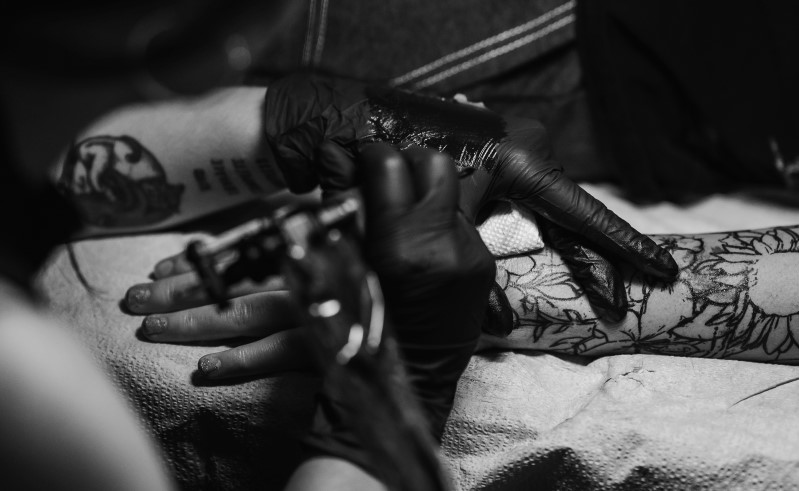
Tattoo 101: Terminology
Aftercare:
This is the caring of your tattoo & skin for the first few weeks after your session. Getting a tattoo doesn't end when the needle stops, it's important to follow-up with proper treatment afterward.
American Traditional:
Much of the iconic tattoo imagery that comes to mind when think about what a tattoo looks like is done in this style. Generally done with a black outline and bold color palette.
Biomechanical:
Often shortened to just biomech, the intent of this style is to incorporate a robotic or mechanical look into skin. Think of it as melding human with machine, often times taking great care to make sure it flows well with muscle structure.
Black and Grey:
These type of tattoos are done only using black ink and a variety of diluted gray tones. Photo-realistic portraits can do quite well with this style, as the often hold up better long-term compared to full color portraits.
Blackwork:
Done only with black, this style is commonly used for tribal or geometric designs.
Blowout:
This can happen if the tattoo is not properly applied, most commonly with the needle going too deep, the needle at the wrong angle, or the skin stretched too much. A cloudy or blurry look around the lines is usually a sign of a blowout.
Coil Machine:
A tattoo machine that uses an electromagnetic coil to oscillate the needle grouping up and down. These machines are the most commonly seen and used.
Cosmetic Tattoos:
Otherwise known as a medical tattoo or permanent makeup. Commonly applied for clients long after chemotherapy for eyebrows or breast reconstruction.
Cover-Up:
Tattooing over a previously unwanted tattoo with a new tattoo. These tattoos require special attention to the design process to ensure the old design is camouflaged properly.
Dotwork:
A tattoo that entirely is made from dots. Common usage is for sacred geometry or stipple portraits.
Flash:
For walk-in customers that don't have pre-existing artwork they want to use, these are pre-drawn & pre-colored designs. Typically hung on a wall or placed in a binder if flash is available at the shop.
Free Hand:
A tattoo design that is drawn on the client's skin without using a stencil.
Fresh:
A new tattoo that has not healed yet. Generally described as feeling similar to a sunburn, and this is the period of time when the tattoo will be the most vibrant.
Healed:
Skin that has accepted the ink and returned back to a normal texture. Generally, this is 2-4 weeks after the tattoo has been applied.
Horror:
Often done with dark imagery, either black & gray or in full color. Not uncommon to include figures from horror films, books, or games.
Illustrative:
A hybrid of realism & traditional. Typically includes bold outlines along with realistic shading.
Neo:
Used a pre-fix for some styles, such as "Neo"-Traditional. The main difference between being that the "Neo" version will have more realistic depth & shading.
New School:
Illustrative but with portions of the image exaggerated to give it a cartoonish look.
Ornamental:
Commonly done with geometric shapes that flow with certain parts of the body.
Pin-Up:
Made famous in the American Traditional style from the early 1900's, these are typically a classic style involving images of women.
Portfolio:
An artist's collection of past work. It's important to find an artist that you like the style of; do a deep dive in their Instagram to make sure the particular style they do aligns with what you want to get done.
Realism:
Simply put, it's trying to make an image look like it would be in real life. These are usually more shading work than line work to give that life-like appearance.
Rotary Machine:
These work on a spinning motor that moves the attached needle up and down which can provide a smoother motion. These can be compared to coil machines, these are quieter and can lead to less damage to the skin which means faster healing.
Saturation:
How much ink has been absorbed into the skin. A well saturated design can look very solid.
Scarring:
This can happen when the tattoo needs go into the deeper layers of more sensitive and delicate tissue of your body or when an area is worked over too much.
Shop / Studio:
Usually a shop allows for walk-in clients whereas a studio is more about appointment-only custom tattoos
Sleeve:
A tattoo that spans the majority of the length of a limb. Most commonly this is a wrist to shoulder design, but can also be an ankle to hip design for the legs as well.
Stencil:
The paper to skin design transfer process. This will give the artist a temporary guide to where the lines and shading should be.
Stick & Poke:
Usually a DIY type tattoo involving a single needle.
Tattoo Machine:
The device used to apply tattoos. Please refer to coil machine and rotary machine for the most common machines used today.
Trash Polka:
A collage of images, usually realism and abstract. Most commonly done with black & red inks.
Tribal:
A modern imitation of traditional Polynesian body art. Typically done with big black bold semi-organic lines.
Watercolor:
A style of tattooing that's intended to have a brushstroke aesthetic while using colors seen in watercolor paintings.
